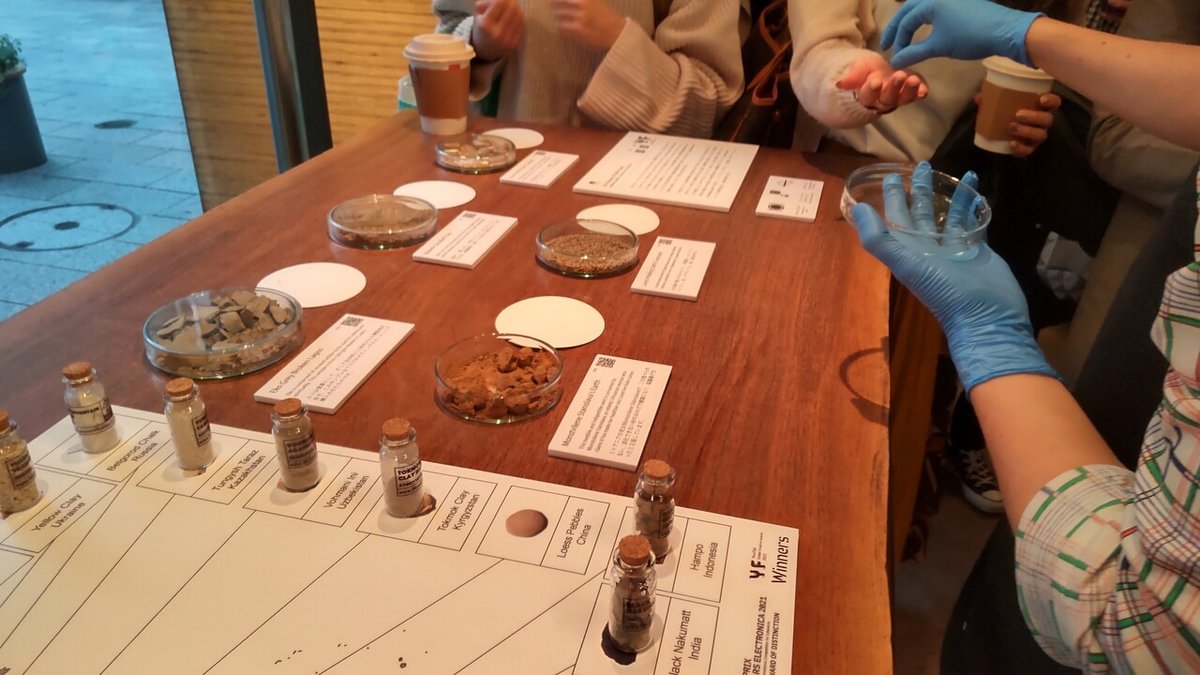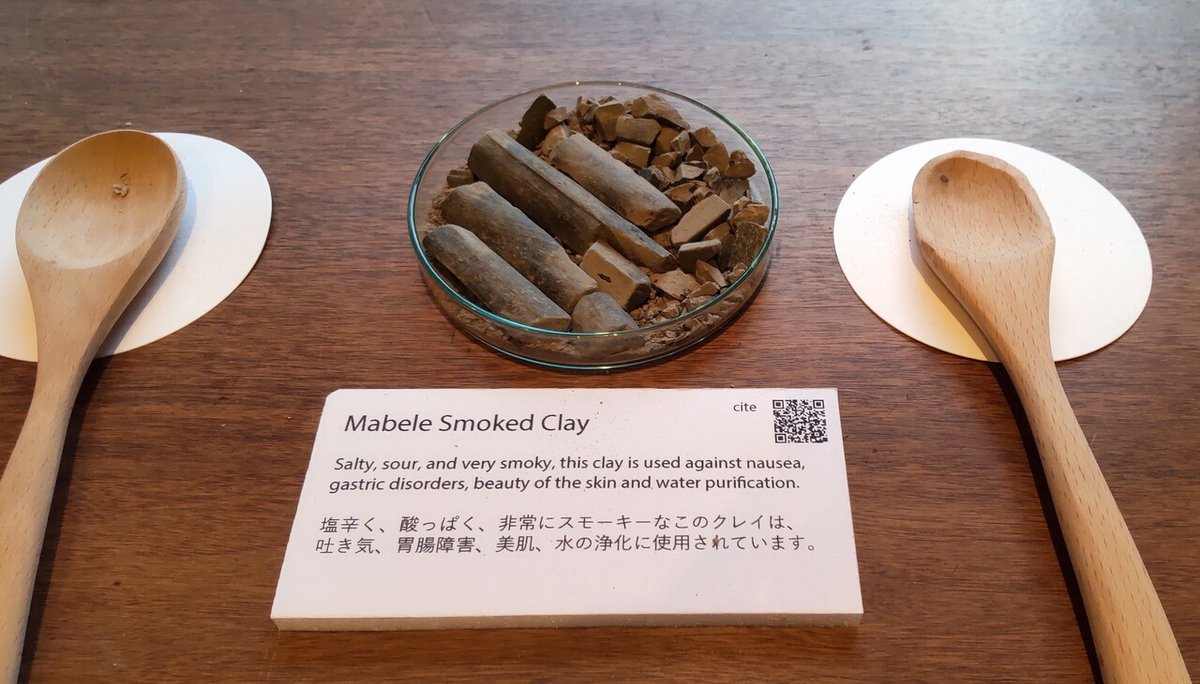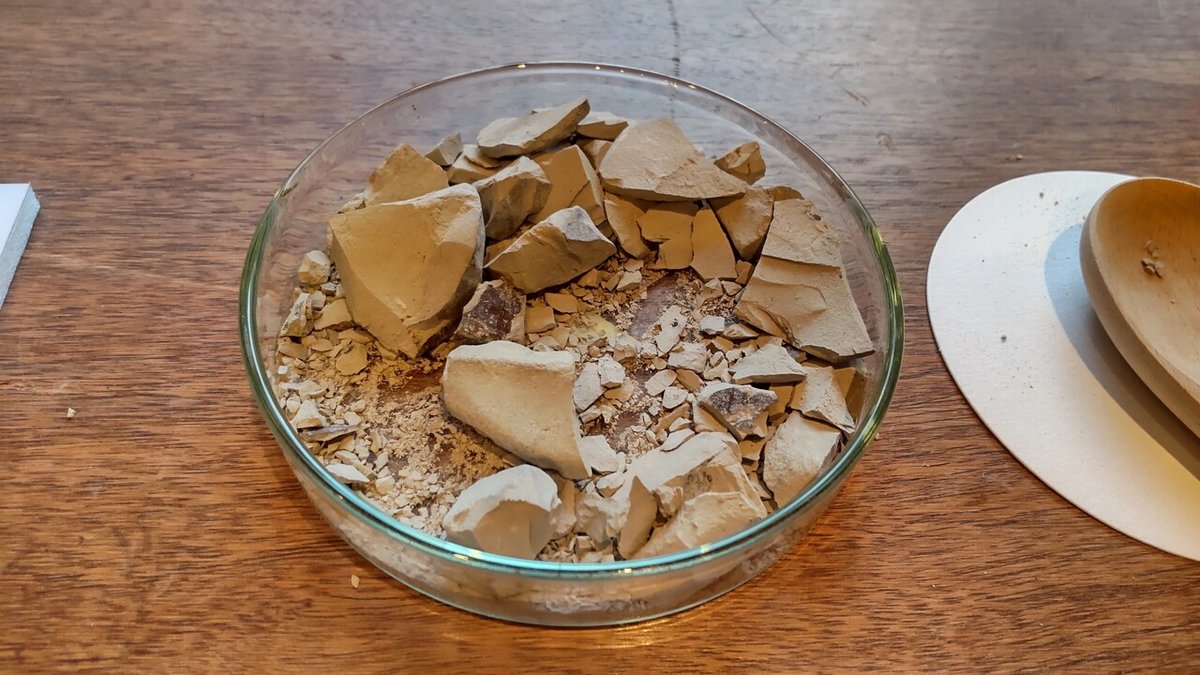
足元の「土」を食べる。
「土」をスナックのようにカジュアルに食べる地域があるという。
それも世界中のあちこちに。
貧血などで本能的にミネラルを欲して食べてしまう例があることは聞いたことがあったが、嗜好品として楽しむというのは初耳だった。
食べてもいいそうだ、土。
足元を見ればこんなにたくさんあるし、これが全部タダで食べられると思うと興奮しないだろうか。
【Eat the "soil" at your feet】
It is said that there are areas where you can eat "soil" casually like a snack,all over the world. I've heard that there are cases where people instinctively want minerals and eat them due to anemia, but it was the first time to hear some people enjoying them as a luxury item. If you look at your feet, there are so many, and wouldn't you be excited to think that you can eat all of this for free?



【わが国でも土は食べられていた】
昔、本宮ひろ志さんの「大飢饉」という漫画で読んだことがあったのは、土から養分だけを抽出した「土粥 (つちがゆ)」と呼ばれるもの飲んで飢饉を生き延びるという話で、高度な学問を受けられなかった時代に先人たちが経験からそんな方法を編み出していたことに衝撃を受けたが、嗜好品としてそのまま食べる習慣が世界のあちこちにあるというのも新たな衝撃だった。
「土粥」は食物が確保できない非常事態を克服するための救荒食(きゅうこうしょく)と呼ばれる、本来は食用ではないものを食用とする知恵だが、アイヌの人々は日常食として「珪藻土」を利用していたことを知った。
珪藻土はアイヌ語で「chi-e-toy (チエトィ)」 で「我ら・食べる・土」という意味だそうだ。
この「我らの食べる土」 を水に溶いて煮立てたものにハナウドの葉柄、ウラジロタデの若い茎、クロユリの鱗茎などを搗き潰して加え、獣魚油を加えた料理を樺太では「チカリぺ (chikaripe)」、北海道北東部では「レタシケプ (retaskep)」、南西部では「ラタシケㇷ゚ (rataskep)」と呼んだらしい。
同じ食材を使った料理であるにも関わらず呼び名が異なるということは、各集落の人々がそれぞれ珪藻土が食べられことに気づき、その地域で採れる動植物を利用して口に合うように進化させていった「郷土料理」なのではないだろうか。
彼らはこの料理を「甘い」と言って、「これほど美味しい御馳走はない」と語ったという。
上記の煮込み料理以外に珪藻土と山菜を和えたりもしていたようだが、いずれにしても珪藻土を用いたのは野草のアクを抜き、強烈は獣魚油を適度に中和するのに有効なことを経験から学んでいたらしい。
さらには珪藻土には汁に「とろみ」をつける作用があるそうなのだが、この「とろみ」は、食材が貴重な土地において少量で満腹感を得たり、極寒の地で汁を冷めにくくすることにも貢献したのではないかと個人的に想像する。
いずれにしても悪条件を克服して生き延びる彼らの経験と知恵には感服するしかない。
【Soil was also eaten by Japanese with wisdom for surviving】
A long time ago, I read in Hiroshi Motomiya's manga "Great Famine" about how to survive the famine by drinking something called "earth porridge", which is made by extracting only nutrients from the soil. I was shocked that the ancestors had devised such a method from experience in the days when it was not possible to learn academic basis, but it was also a new shock that there are habits of eating as it is as a luxury item all over the world.
the soil porridge is a wisdom to eat something that is not originally edible, which is called famine food to overcome emergencies where food cannot be secured, but Ainu people who are native poeple in norhern Japan use "diatomaceous earth" as their daily food.
Diatomaceous earth is the Ainu word for "chi-e-toy," which means "we, eat, and soil."
This "earth we eat" is boiled in water, and the petioles of Hanaud, young stems of urajirotade, and scales of black lily are crushed and added, and the dish with animal or fish oil is added.
this dish is called to "chikaripe" in Sakhalin. It seems that it was called "retaskep" in the northeastern part of Hokkaido and "rataskep" in the southwestern part.
The fact that the dishes are made with the same ingredients but have different names means that people in each village have noticed that diatomaceous earth can be eaten, and have evolved to suit their tastes by using the flora and fauna that can be harvested in that area as a "local dish".
They said the dish was "sweet" and "there is no better treat than this."
They also eat mixed diatomaceous earth and edible wild plants, using diatomaceous earth is effective in removing wild grass lye and neutralizing animal fish oil moderately. It seems that they learned from their experience.
Furthermore, diatomaceous earth is said to have the effect of adding "thickness" to the soup.
I personally imagine that this "thickness" contributed to the feeling of fullness with a small amount of ingredients and to keeping it warm the soup especially in extremely cold and difficult to keep enough food regions.
In any case, I admire their experience and wisdom to against grueling conditions for surviving.



【土を食べるということ】
現代においては土を食べることについての研究者も現れ、メリット、デメリットがより詳細に分析されているようだが、土に含まれる成分は土地によって異なるし、わたくしのように興味本位で知りたがるには奥が深すぎる。
ただ、衛生管理がなされていない場所で加工された食用土はバクテリアや不純物が取り除けておらず危険なことはわかる。土を日常的に食べる習慣がある国々の女性たちが地べたに座って素手でこねている食用土の写真を見て、もし、それらを現地で勧められたとしても口に入れるには覚悟が必要だと肝に銘じた。
【What I've learnt】
In modern times, researchers about eating soil have appeared, and it seems that the advantages and disadvantages are analyzed in more detail, but the components contained in soil differ depending on the land, and I want to know with interest but It's too deep like earth.
However, it turns out that edible soil processed in places where hygiene is not controlled is dangerous because bacteria and impurities cannot be removed. Look at pictures of edible soil that women from countries that have a habit of eating soil on a daily basis are sitting on the ground and kneading with their bare hands, and even if they are recommended locally, you need to be prepared to eat them.





【21世紀の日本で『土』を食べてみた】
土を試食させてもらえるワークショップで「ここで土を食べることは自己責任」という同意書に署名をしてから実際に「土」を食べてみた。
感想は、ものによっては美味しいということだった。
口さみしい時にスナックとして齧りたくなるかもしれない。
フレーバーを加えてるわけではないのにうっすらミントのような清涼感を感じるものや、いい感じに後を引く塩味のものもあった。
これこそ大地の味、地球の味、と思うとロマンを感じるが、転んで口に入ったらこんな感じかもしれないと思うようなものもあった。
植木鉢の中で見たことがあるような見た目で、ひどくジャリジャリしていた。これは食用として広く好まれている土とは異なり、一人のリトアニアの老女がひたすら食べていたものだそうだ。
老女が好んだ土は、全て飲み込んだつもりでも奥歯に微かな粒子が残り、忘れた頃に何かの拍子でジャリっとして「あ、そうだ、今日、土食べたんだった」と思い出させてくれた。
ものすごく非日常的なことをしたんだなとしみじみ思う。
【Taste of soil】
At an event where I was allowed to sample the soil, I signed the agreement that "it is my responsibility to eat the soil here" and then actually tried the "soil".
The impression was that some things were delicious.
You may want to bite as a snack when you're humming.
Some had a slightly mint-like refreshing sensation even though no flavor was added, while others had a nice salty taste.
It's romantic when I think that this is the taste of the earth, but there were also things that I thought might be like this when I fell down and put it in my mouth.
It looked like I had seen it in a flowerpot, and it was terribly jerky. This is different from the soil that is widely preferred for food, and it is said that it was eaten by an old Lithuanian woman.
after a while even though I thougt I had swallowed it all, but there were tiny particles left on my back teeth and It made me remind "Oh, yes, today. I ate the soil. "
I think I did something extremely extraordinary.





【土は漢方薬に似ていた】
食用土の形状は、こねて固めて乾かしてから焼かれたちょっとしたレンガのような硬めのものや、丸めて乾かしただけのようは柔らかいものまで多種多様だった。ドイツ製のものは顆粒状に加工されて健康食品として流通していたり、カプセルに詰められてサプリメントとして扱われているものもあった。
これらは胃の不調で悩まされていた時期に医師に処方された漢方薬を思い出させた。
わたしが服用していたものは草木や根を乾燥させたままの生薬ではなく、それらから有効成分だけが抽出されて顆粒状に加工された飲みやすいものだったが、それでも後味が土臭く、生薬となる草木が「土」のエキスで成長しているからなのかもしれないと、土を食べる経験をして気がついた。
もしかすると、植物以外に「土」も薬にされていたのではないかと思いつき、調べてみたらあった。
江戸時代、医者の処方する薬は高価なため、民間療法に頼らざるを得なかった庶民の間では「土」そのものが薬にされていた。
元禄6年(1693)に庶民のためにまとめられた『救民妙薬』という家庭医学書に「伏龍肝(ぶくりゅうかん)」という名前で、当時はどこの家にもあった竈の中央の焼けた「黄土」が難産に効くと紹介されていたそうだ。
もとは中国・明代に李時珍がまとめた『本草綱目』に記載があるそうで、そこでは主に吐血や長引く生理など「出血を止める」ために服用されたらしいが、酒に溶いて背中のできものに塗るという外用薬としての使い方も記されていたようだ。
後世の見解では「黄土」はカリウムやナトリウム、カルシウム、二酸化ケイ素が含まれているため、これらのミネラルが薬効として働いたのではないかとのことだが、このような分析情報がなかった当時の人々は経験と知恵から見出しているのだから、すごい。
【Soil reminds me of Chinese herbal medicine】
There were various shapes of edible soil, from hard ones like a little brick that was kneaded and burnt, hardened and dried, and soft ones that were just rolled and dried. Some of them made in Germany were processed into granules and distributed as health foods, and some were packed in capsules and treated as supplements.
These various earth, especially not processed one reminded me of the Chinase herbal medicine prescribed by my doctor when I was suffering from stomach upset.
What I was taking was not a crude drug with raw plants and roots, but an easy-to-drink one in which only the active ingredient was extracted and processed into granules, but the aftertaste was still earthy and the crude drug. I noticed from the experience of eating soil that it may be because the plants and trees that become the roots are growing with the extract of "soil".
Perhaps I thought that "soil itself" was also used as a medicine in addition to plants, and I found a fact as I thought. In the Edo period, medicines prescribed by doctors were expensive, so the "earth" itself was used as a medicine among the common people who had to rely on folk remedies.
In the 6th year of Genroku (1693), a family medical book called "Rescue Myoyaku" was compiled for the common people, and the name was "Bukuryukan". It was introduced that the burnt "yellow clay" is effective for dystocia.Originally, it is said that it is described in "Honso-tsuname" compiled by Li Shizhen in the Ming dynasty of China, where it seems that it was taken mainly to "stop bleeding" such as hematemesis and prolonged menstruation, It seems that it was also described as an external medicine by dissolving in alcohol, for a boil on your back skin to heal.
In posterity's view, "loess" contains potassium, sodium, calcium, and silicon dioxide, so these minerals may have worked as medicinal properties, but people at that time did not have such analytical information. Is amazing because it is found from experience and wisdom.





【海外の土食事情】
土を食べる習慣を持つ民族たちが様々な事情から移民となり、移民先の国でその習慣をそのまま続けているケースも多くあるそうだ。
オランダでは衛生面から政府が手作り食用土の販売を禁止したという。
しかし、民族によっては神と交流する大事な儀式の供物として必要不可欠だったり、単に味が好きだったりという理由から違法と知ってか知らずか、今なお製造販売されているらしい。
【what I've heard about overseas soil eating】
It is said that there are many cases where ethnic groups who have a habit of eating soil have become immigrants due to various reasons and continue to have that habit in the country of immigration.
In the Netherlands, the government has banned the sale of homemade edible soil for hygiene reasons. However, depending on the ethnic group, it is indispensable as an important ritual offering to interact with God, or it seems that it is still manufactured and sold, whether it is illegal or not because it simply likes the taste.


【土は美味しい】
様々な食用土を試食してみたが、個人的には味と食感を楽しみたいので品質管理された先進国の健康食品よりも、現地人が「こねて固めて焼いたもの」が好みだった。
土食の研究関係者でもない一般人が日本でこれだけの種類の「土」を一度に試食した例は極めて少ないのではないだろうか。
誰かが世界で一番不味いと言ったフィンランドのサルミアッキや、ヨーロッパやオーストラリアでは老若男女に愛されているアルミサッキのマイルド版のようなLiquorice(リコリッシュ)の風味が大好きなので、もしかすると土が美味しく感じられたのも、この先、日本国内で土を食べる機会がないだろうと思うと残念な気がしてならないのも、この国ではわたくしだけかもしれないと思ってしまう。
それにしても美味しかったな、「土」。
【I will miss the taste of Soil】
I tried various edible soils, but personally I want to enjoy the taste and texture, so I prefer "kneaded and baked" to the quality-controlled health foods of developed countries.
I was very lucky that I had a chance to try such various of soil even though I am not involved in geophagia research.
I think there are very few examples of tasting much soil at once in Japan.
I love the flavor of Finnish salty liquorice "salmiakki", which someone said is the worst taste in the world, and Liquorice, which is like the mild version of salmiakki, which is loved by men and women of all ages in Europe and Australia, my taste of favourites are bit unique among Japanese that might be why the soil feels delicious.
I think I might be only person in this country who should feel sorry for the fact that I will not have the opportunity to eat soil in Japan in the future.
Even so, it was delicious, "soil" for me.

